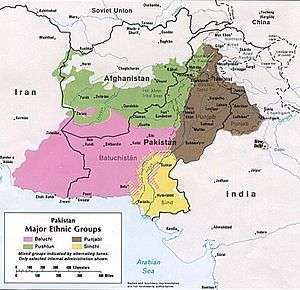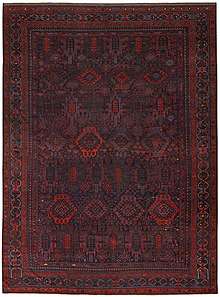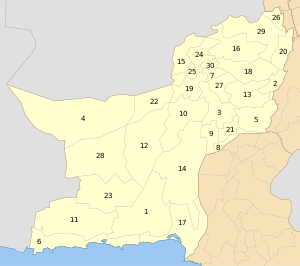Balochistan
Balochistan[4] (/bəˈlɒtʃɪstɑːn/; Balochi: بلوچِستان; also Baluchistan) is an arid desert and mountainous region in south-western Asia. It comprises the Pakistani province of Balochistan, the Iranian province of Sistan and Baluchestan, and the southern areas of Afghanistan, including Nimruz, Helmand and Kandahar provinces.[5][6] Balochistan borders the Pashtunistan region to the north, Sindh and Punjab to the east, and Persian regions to the west. South of its southern coastline, including the Makran Coast, are the Arabian Sea and the Gulf of Oman.
Balochistan بلوچِستْان | |
|---|---|
 Balochistan region in pink | |
| Countries | |
| Population (2013) | |
| • Total | c. 18–19 million[1][2][3] |
| Demographics | |
| • Ethnic groups | Baloch |
| • Languages | Balochi Minor: Brahui, Pashto, Persian, Urdu |
| Largest cities | |
Etymology
The name "Balochistan" is generally believed to derive from the name of the Baloch people.[5] The Baloch people are not mentioned in pre-Islamic sources. It is likely that the Baloch were known by some other name in their place of origin and that they acquired the name "Baloch" after arriving in Balochistan sometime in the 10th century.[7]
Johan Hansman relates the term "Baloch" to Meluḫḫa, the name by which the Indus Valley Civilisation is believed to have been known to the Sumerians (2900–2350 BC) and Akkadians (2334–2154 BC) in Mesopotamia.[8] Meluḫḫa disappears from the Mesopotamian records at the beginning of the second millennium BC.[9] However, Hansman states that a trace of it in a modified form, as Baluḫḫu, was retained in the names of products imported by the Neo-Assyrian Empire (911–605 BC).[10] Al-Muqaddasī, who visited the capital of Makran - Bannajbur, wrote c. 985 AD that it was populated by people called Balūṣī (Baluchi), leading Hansman to postulate "Baluch" as a modification of Meluḫḫa and Baluḫḫu.[11]
Asko Parpola relates the name Meluḫḫa to Indo-Aryan words mleccha (Sanskrit) and milakkha/milakkhu (Pali) etc., which do not have an Indo-European etymology even though they were used to refer to non-Aryan people. Taking them to be proto-Dravidian in origin, he interprets the term as meaning either a proper name milu-akam (from which tamilakam was derived when the Indus people migrated south) or melu-akam, meaning "high country", a possible reference to Balochistani high lands.[12] Historian Romila Thapar also interprets Meluḫḫa as a proto-Dravidian term, possibly mēlukku, and suggests the meaning "western extremity" (of the Dravidian-speaking regions in the Indian subcontinent). A literal translation into Sanskrit, aparānta, was later used to describe the region by the Indo-Aryans.[13]
During the time of Alexander the Great (356–323 BC), the Greeks called the land Gedrosia and its people Gedrosoi, terms of unknown origin.[14] Using etymological reasoning, H. W. Bailey reconstructs a possible Iranian name, uadravati, meaning "the land of underground channels", which could have been transformed to badlaut in the 9th century and further to balōč in later times. This reasoning remains speculative.[15]
History

The earliest evidence of human occupation in what is now Balochistan is dated to the Paleolithic era, represented by hunting camps and lithic scatter, chipped and flaked stone tools. The earliest settled villages in the region date to the ceramic Neolithic (c. 7000–6000 BCE) and included the site of Mehrgarh in the Kachi Plain. These villages expanded in size during the subsequent Chalcolithic when interaction was amplified. This involved the movement of finished goods and raw materials, including chank shell, lapis lazuli, turquoise, and ceramics. By 2500 BCE (the Bronze Age), the region now known as Pakistani Balochistan had become part of the Harappan cultural orbit,[16] providing key resources to the expansive settlements of the Indus river basin to the east.
From the 1st century to the 3rd century CE, the region was ruled by the Pāratarājas (lit. "Pārata Kings"), a dynasty of Indo-Scythian or Indo-Parthian kings. The dynasty of the Pāratas is thought to be identical with the Pāradas of the Mahabharata, the Puranas and other Vedic and Iranian sources.[17] The Parata kings are primarily known through their coins, which typically exhibit the bust of the ruler (with long hair in a headband) on the obverse, and a swastika within a circular legend on the reverse, written in Brahmi (usually silver coins) or Kharoshthi (copper coins). These coins are mainly found in Loralai in today's western Pakistan.
Herodotus in 450 BCE described the Paraitakenoi as a tribe ruled by Deiokes, a Persian king, in northwestern Persia (History I.101). Arrian describes how Alexander the Great encountered the Pareitakai in Bactria and Sogdiana, and had them conquered by Craterus (Anabasis Alexandrou IV). The Periplus of the Erythraean Sea (1st century CE) describes the territory of the Paradon beyond the Ommanitic region, on the coast of modern Balochistan.[18]
The Hindu Sewa Dynasty ruled parts of Balochistan, chiefly Kalat.[19][20] The Sibi Division, which was carved out of Quetta Division and Kalat Division in 1974, derives its name from Rani Sewi, the queen of the Sewa dynasty.[21]
The region was fully Islamized by the 9th century and became part of the territory of the Saffarids of Zaranj, followed by the Ghaznavids, then the Ghorids. Ahmad Shah Durrani made it part of the Afghan Empire in 1749. In 1758 the Khan of Kalat, Mir Noori Naseer Khan Baloch, revolted against Ahmed Shah Durrani, defeated him, and freed Balochistan, winning complete independence.[22][23][24][25]
In the 1870s, Baluchistan came under control of the British Indian Empire in colonial India.[26] During the time of the Indian independence movement, "three pro-Congress parties were still active in Balochistan's politics", such as the Anjuman-i-Watan Baluchistan, which favoured a united India and opposed its partition.[27][28]
Governance and political disputes
The Balochistan region is administratively divided among three countries, Pakistan, Afghanistan, and Iran. The largest portion in area and population is in Pakistan, whose largest province (in land area) is Balochistan. An estimated 6.9 million of Pakistan's population is Baloch. In Iran there are about two million ethnic Baloch[29] and a majority of the population of the eastern Sistan and Baluchestan Province is of Baloch ethnicity. The Afghan portion of Balochistan includes the Chahar Burjak District of Nimruz Province, and the Registan Desert in southern Helmand and Kandahar provinces. The governors of Nimruz province in Afghanistan belong to the Baloch ethnic group.
In Pakistan, insurgencies by Baloch nationalists in Balochistan province have been fought in 1948, 1958–59, 1962–63 and 1973–1977 – with a new ongoing and reportedly stronger, broader insurgency beginning in 2003.[30] Historically, drivers of the conflict are reported to include "tribal divisions", the Baloch-Pashtun ethnic divisions, "marginalization by Punjabi interests", and "economic oppression".[31]
In Iran, separatist fighting has reportedly not gained as much ground as the conflict in Pakistan,[32] but has grown and become more sectarian since 2012,[29] with the majority-Sunni Baloch showing a greater degree of Salafist and anti-Shia ideology in their fight against the Shia-Islamist Iranian government.[29]
Music
The main instruments of Baluchi music are the sorud fiddle, the doneli double flute, the benju zither, the tanburag lute, and the dholak.
References
- Iran, Library of Congress, Country Profile . Retrieved December 5, 2009.
- Afghanistan, CIA World Factbook . Retrieved December 5, 2009.
- Central Intelligence Agency (2013). "The World Factbook: Ethnic Groups". Retrieved 3 November 2014.
- Other variations of the spelling, especially on French maps, include Beloutchistan and Baloutchistan.
- Pillalamarri, Akhilesh (12 February 2016). "A Brief History of Balochistan". thediplomat.com. THE DIPLOMAT. Retrieved 18 June 2016.
- "Human Rights in Balochistan: A Case Study in Failure and Invisibility". THE HUFFINGTON POST. 25 March 2016. Retrieved 18 June 2016.
- Elfenbein, J. (1988), "Baluchistan iii. Baluchi Language and Literature", Encyclopaedia Iranica
- Parpola 2015, Ch. 17: "The identification of Meluhha with the Greater Indus Valley is now almost universally accepted."
- Hansman 1973, p. 564.
- Hansman 1973, p. 565.
- Hansman 1973, pp. 568–569.
- Parpola & Parpola 1975, pp. 217–220.
- Thapar 1975, p. 10.
- Bevan, Edwyn Robert (12 November 2015), The House of Seleucus, Cambridge University Press, p. 272, ISBN 978-1-108-08275-4
- Hansman 1973
- Doshi, Riddhi (17 May 2015). "What did Harappans eat, how did they look? Haryana has the answers". Hindustan Times. HT Media.
- Tandon 2006, p. 183.
- Tandon 2006, pp. 201–202.
- Fowle, T. C.; Rai, Diwan Jamiat (1923). Baluchistan. Directorate of Archives, Government of Balochistan. p. 100.
The Hindus of Kalat town may indeed be far more indigenous since they claim descent from the ancient Sewa dynasty that ruled Kalat long before the Brahuis came to Baluchistan.
- Balochistan Through the Ages: Geography and history. Nisa Traders. 1979. p. 316.
The country up to and including Multan was conquered by the Arabs and the Hindu dynasty of Sind and probably also the Sewa dynasty of Kalat came to an end.
- Quddus, Syed Abdul (1990). The Tribal Baluchistan. Ferozsons. p. 49. ISBN 978-969-0-10047-4.
The Sibi division was carved out of the Quetta and Kalat Divisions in April, 1974, and comprises districts of Sibi, Kachhi, Nasirabad, Kohlu and Dera Bugti. The Division derives its name from the town of Sibi or Sewi. The local tradition attributes the origin of this name to Rani Sewi of the Sewa dynasty which ruled this part of the country in ancient times.
- "Ahmad Shah and the Durrani Empire". Library of Congress Country Studies on Afghanistan. 1997. Retrieved 23 September 2010.
- Friedrich Engels (1857). "Afghanistan". Andy Blunden. The New American Cyclopaedia, Vol. I. Archived from the original on 18 October 2010. Retrieved 23 September 2010.
Afghanistan ... an extensive country of Asia ...between Persia and the Indies, and in the other direction between the Hindu Kush and the Indian Ocean. It formerly included the Persian provinces of Khorassan and Kohistan, together with Herat, Beluchistan, Cashmere, and Sinde, and a considerable part of the Punjab ... Its principal cities are Kabul, the capital, Ghuznee, Peshawer, and Kandahar
- "Aḥmad Shah Durrānī". Encyclopædia Britannica. 2010. Retrieved 25 August 2010.
- Clements, Frank (2003). Conflict in Afghanistan: a historical encyclopedia. ABC-CLIO. p. 81. ISBN 978-1-85109-402-8. Retrieved 23 September 2010.
- Henige, David P. (1970). Colonial Governors from the Fifteenth Century to the Present: A Comprehensive List. University of Wisconsin Press. p. 89.
The British began to assume control over the rough desert region in extreme western India known as Baluchistan in the 1870s.
- Afzal, M. Rafique (2001). Pakistan: History and Politics 1947-1971. Oxford University Press. p. 40. ISBN 978-0-19-579634-6.
Besides the Balochistan Muslim League, three pro-Congress parties were still active in Balochistan's politics: the Anjuman-i Watan, the Jamiatul Ulama u Hind, and the Qalat State National Party.
- Ranjan, Amit (2018). Partition of India: Postcolonial Legacies. Taylor & Francis. ISBN 9780429750526.
Furthermore, Congress leadership of Balochistan was united and there was no disagreement over its president, Samad Khan Achakzai. On the other hand, Qazi Isa was the president of the League in Balochistan. Surprisingly, he was neither a Balochi nor a Sardar. Consequently, all Sardars except Jaffar Khan Jamali, were against Qazi Isa for contesting this seat.
- Grassi, Daniele (20 October 2014). "Iran's Baloch insurgency and the IS". Asia Times Online. Retrieved 26 June 2015.
- Hussain, Zahid (Apr 25, 2013). "The battle for Balochistan". Dawn. Retrieved 22 June 2015.
- Kupecz, Mickey (Spring 2012). "PAKISTAN'S BALOCH INSURGENCY: History, Conflict Drivers, and Regional Implications" (PDF). International Affairs Review. 20 (3): 106. Archived from the original (PDF) on 1 July 2015. Retrieved 24 June 2015.
- Bhargava, G. S. "How Serious Is the Baluch Insurgency?" Asian Tribune (April 12, 2007). Retrieved December 2, 2011.
Bibliography
- Hansman, John (1973), "A Periplus of Magan and Meluhha", Bulletin of the School of Oriental and African Studies, 36 (3): 553–587, doi:10.1017/S0041977X00119858, JSTOR 613582
- Hansman, John (1975), "A further note on Magan and Meluhha (Notes and Communications)", Bulletin of the School of Oriental and African Studies, 38 (3): 609–610, doi:10.1017/s0041977x00048126, JSTOR 613711
- Parpola, Asko; Parpola, Simo (1975), "On the relationship of the Sumerian toponym Meluhha and Sanskrit mleccha", Studia Orientalia, 46: 205–238
- Parpola, Asko (2015), The Roots of Hinduism: The Early Aryans and the Indus Civilization, Oxford University Press, ISBN 978-0-19-022692-3
- Tandon, Pankaj (2006), "New light on the Pāratarājas" (PDF), Numismatic Chronicle, 166, JSTOR 42666407
- Thapar, Romila (January 1975), "A Possible Identification of Meluḫḫa, Dilmun and Makan", Journal of the Economic and Social History of the Orient, 18 (1): 1–42, doi:10.1163/156852075x00010, JSTOR 3632219
External links
- Persia (Iran), Afghanistan and Baluchistan is a map from 1897 published by The Century Company
- Afghanistan, Beloochistan, etc. is a map from 1893 published by the American Methodist Church
- Balochistan Archives- Preserving our Past
